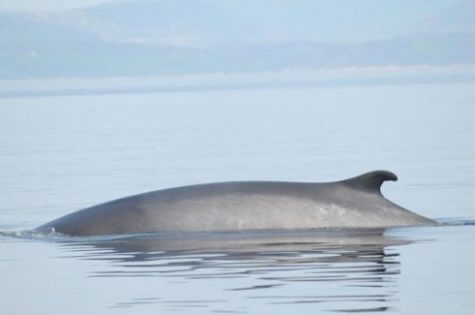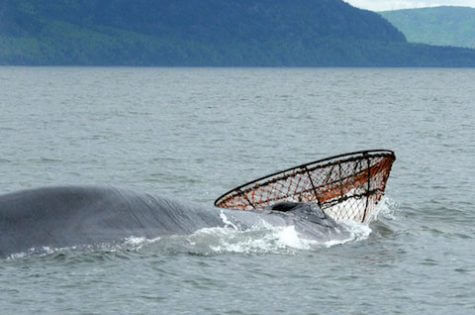Capitaine Crochet
Fin Whale


-
ID number
Bp050
-
Sex
Femelle
-
Year of birth
Inconnue (mort en 2013)
-
Known Since
1994
Ses traits distinctifs
Un seul coup d’œil sur sa nageoire dorsale permet de reconnaitre Capitaine Crochet. C’est en effet sa forme courbée qui lui a valu son nom. En outre, le patron de coloration de son chevron mérite l’attention. Chez les rorquals communs, le dessin du chevron situé à l’arrière de la tête est constitué de bandes et de lignes grises plus ou moins claires. Le chevron du côté droit, plus clair, fait partie des marques qui permettent l’identification des individus. Il est très contrasté chez les baleineaux et s’estompe au fil des années. Or, chez Capitaine Crochet, il est resté très contrasté. C’est son air de jeunesse!
Life history
A faithful visitor to the estuary and known for spending long periods there, Capitaine Crochet, a 60-ton female fin whale, was a real star.
Since 1994, she usually arrived in the spring and stayed for several weeks or even months. The head of the Laurentian Channel (between Tadoussac and Les Bergeronnes) was her favorite spot.
It is not known where this estuary regular was before her first sighting. Some fin whales have been identified every year since 1986. It is possible that she adopted the estuary as her summer territory late in life or that her transition to adulthood made her unrecognizable to researchers.
Capitaine Crochet has been observed several times accompanied by a calf. However, in the absence of a biopsy of the calf seen alongside her in 2012, it cannot be confirmed whether she was its mother. To verify the parentage, researchers must observe the female with the same calf on several occasions. A biopsy will then reveal the genetic relationship between the two individuals, if any. Such precautions are necessary because in this species, weaned calves are often accompanied by adults other than their mothers.
In the spring of 2013, Capitaine Crochet was missing. On June 6, she was spotted by a team from the Saguenay–St. Lawrence Marine Park; however, she was in a predicament, entangled in crab fishing gear, with a huge trap on her head.
Parks Canada and the Quebec Marine Mammal Emergency Response Network Coordination Center ensured the smooth running of the rescue operation, which also mobilized the marine park team. They consulted numerous experts, ranging from fishermen to veterinarians to whale disentanglement specialists. Rescuers made several attempts to free her, but these were unsuccessful.
Whales swimming freely with fishing gear can sometimes survive for up to three years. However, most do not survive more than six months.
According to several specialists, Capitaine Crochet was one of the worst cases of accidental entanglement imaginable. The chances of freeing her were slim, and even if she had been freed, there were fears for her survival due to her emaciation, injuries, and risk of infection. She has not been seen since June 13, 2013, suggesting that she may have died as a result of her entanglement.
Observations history in the Estuary
Years in which the animal was not observed Years in which the animal was observed
Latest news from the publications Portrait de baleines
Those who have had the privilege of seeing Capitaine Crochet’s unique dorsal fin emerge from the waters of the St. Lawrence River will remember how eagerly awaited her presence was each season! A loyal visitor to the estuary, Bp050 has only failed to appear before her admirers once since she was first sighted in 1994, in 2005. Year after year, this star whale returned to feed in the area, allowing her to be designated a seasonal resident of the marine park. Scientists classify the fidelity of fin whales into three categories: seasonal residents, regular visitors, and occasional visitors. Over the past two years, the most faithful fin whales have been rather discreet in the St. Lawrence. In the estuary, many seasonal residents have not yet been observed or have only made brief visits. So far this season, Bp934 “Caiman” and Bp097 “Zipper,” among others, are still missing.
In addition to her loyalty, Captain Hook made a lasting impression due to the sad event that caused her death, which marks its 10th anniversary this summer. In June 2013, Bp050 was spotted entangled in a huge crab trap. In the St. Lawrence River, nearly one in two fin whales is believed to have been entangled at some point in its life, according to a recent study (Ramp et al., 2021). Fortunately, many technological efforts have been made to reduce the risks. With rope-free traps or rope systems that break easily, the fishing industry has been working hard to advance technology in this area!
A dorsal fin that curves sharply backward and a particularly contrasting chevron pattern: this is indeed the famous fin whale Capitaine Crochet. For several years now, this female has often been the first to arrive in May and stays in the area throughout the season, until late fall.
The color pattern of her chevron is distinctive. In fin whales, the chevron pattern on the back of the head consists of gray bands and lines of varying shades. The chevron on the right side, which is lighter in color, is one of the markings used to identify individuals. It is very contrasting in calves and fades over the years. However, in Capitaine Crochet, it has remained very contrasting. That’s what makes her look so young!
At the start of the season, Capitaine Crochet was missing. On June 6, at midday, she was finally spotted by marine park tour operators, but she was in a bad position, entangled in crab fishing gear, with a huge trap on her head. Her case was taken over by a team from Parks Canada and the Quebec Marine Mammal Emergency Response Network Coordination Center.
- If you encounter Captain Hook in the coming days, report your sighting as soon as possible by calling 1-877-722-5346.
- Do not approach her; it is recommended that you stay more than 400 m away. Stress can aggravate her condition and compromise the success of the intervention by making the whale more skittish.
With a dorsal fin that curves sharply backward and a particularly contrasting chevron pattern, this is undoubtedly the famous fin whale Capitaine Crochet (Bp 050). Seen since May, this female appears to be following her familiar routine, arriving at the beginning of the season for a long stay in her feeding grounds at the head of the Laurentian Channel.
The color pattern of her chevron deserves attention. In fin whales, the chevron pattern on the back of the head consists of gray bands and lines of varying shades. The chevron on the right side, which is lighter in color, is one of the markings used to identify individuals. It is very contrasting in calves and fades over the years. However, Capitaine Crochet’s pattern has remained very contrasting. It gives her a youthful appearance!
At the start of the season, Capitaine Crochet is the only representative of her species in the marine park. Over the coming weeks, other fin whales will arrive from their annual migration to feed in the area.
In 2009, Capitaine Crochet was sometimes seen with a calf. However, it is difficult to determine if it was hers. Young fin whales are only nursed for a few months, and after that, they can be seen with different adults. Only a biopsy of the calf could have determined if Capitaine Crochet was its mother. It will remain a mystery!


